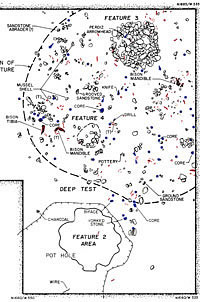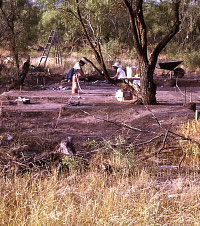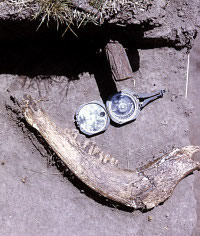Buckhollow Site
The Buckhollow site (41KM16) in western Kimble County is a small campsite repeatedly used by Toyah folk between A.D. 1300 and 1500. Small family groups carried out a variety of tasks centered on hunting at this camp along the bank of Copperas Creek, about 12 miles west of Junction. The preserved remains of these encampments provide insight into the lifeways of small, dispersed groups of hunters during the early part of the Toyah period.
Archeologists from the Texas Department of Transportation excavated the Buckhollow site in 1973 in advance of the construction of Interstate 10. Excavators came across occupations containing arrow points, hide scrapers, bison bones, earthenware pottery, and stone-floored hearths which were attributed to the Toyah Culture. More than a decade after excavations were completed, the site materials were finally analyzed and reported by LeRoy Johnson. While mapping the location of artifacts within the site, Johnson noticed that many were concentrated in a circle around a carefully fashioned hearth. The nature of these artifacts (including arrow points, pottery, and bison bones) and their tight clustering around the hearth led Johnson to suggest that a large brush-walled windbreak had once existed at the site, providing shelter for a kitchen and domestic area.
The bison remains at Buckhollow indicate that Toyah hunters were killing one or two buffalo in the vicinity of the site and bringing back hides as well as those parts of the animal which yielded the best meat. Once the hide and meat were brought back to the campsite, further processing in the form of hide tanning and meat drying likely took place. This evidence may indicate that the site was occupied at a period or season when buffalo were not found in large numbers in the immediate vicinity of the site.
The Buckhollow site represents an important addition to our knowledge of small group behavior during the early part of the Toyah period. However, Johnsonís study of the site is at least as important in that it presents a major synthesis of Toyah culture and advances the notion that this culture was established by immigrant groups following the movement of bison herds into the Edwards Plateau from the northwest.
Reference:
Johnson, LeRoy, Jr.
1994 The Life and Times of Toyah-Culture Folk, The Buckhollow Encampment, Site 41KM16, Kimble County, Texas. Office of
the State Archeologist Report 38, Texas Department of
Transportation and Texas Historical Commission, Austin.


